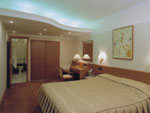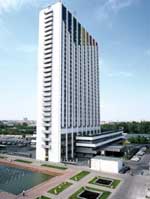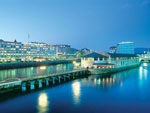The history of this well-known theatre of Moscow starts ine 1913 when some students have decided to create drama studio and to play according to Stanislavsky's system that became very popular recently. Nobody wanted to help young enthusiasts, but, at last, the administration of young troupe was headed by not less young actor and producer Evgeny Bagrationovich Vakhtangov, Stanislavsky’s student.
Very often, rehearsals were held at members’ premises, and Boris Zajtsev's play Lanins’ Estate became the first setting of a newly appeared drama school. The premiere that could become the end of all initiatives was held on 26 March 1914: performance completely failed, and Vahtangov was banned from working with nonprofessionals. But no prohibitions could cool enthusiasm of young actors.
The work continued. Rehearsals were still held in private apartments. Soon Vakhtangov’s studio achieved reconciliation with Moscow Art Theatre. Starting 13 September 1920 it was named MAT’s Third studio. 13 November 1921 marked the opening of the permanent theatre located on Arbat street, 26. This day the enthusiasts who grew to professionals staged St.Anthony’s Miracle. Since then on that day was regarded as the Vakhtangov’s Theatre’s birth date.
True celebration of a theatrical art took place on 27 February 1922 during the premiere of the play Princess Turandot. That night, on 23 February, heavily sick Vakhtangov held dress rehearsal, making actors to rehears stage settings, at 4 am he told the whole cast to repeat the whole performance from the beginning to the end. In the morning, after rehearsal, he came back home and stayed in his bed.
Vakhtangov stayed at home during the premier, and Stanislavsky arrived during the intermission to congratulate the young producer. The intermission was postponed until Stanislavsky's return, when the curtain fell, the audience burst with applauses and exclamations “Bravo to Vakhtangov!”. It was a tremendous success.
On 29 May 1922, at the age of 39, one of the most talented and bright producers and actors of Russia Vahtangov Evgenie Bagrationovich deceased.
Soon after Vakhtangov’s death, the cast approved its own council and refused to join other MAT studios. Members’ cohesion and their strong will to stay together made them a real family.
The theatre had a very stormy life: producers superseded one another, some performances excited the audience, other remained unnoticed. But the theatre did not give up and preserved to Vakhtangov’s ideas of facile festivity hiding the deep psychology. Performances by Bulgakov and Olesha drew strong criticism of authorities. The situation in country was considerably hardened. Many young theatres were closed, and their actors and producers disappeared in prisons. But the Vahtangov’s Theatre had the influential patrons, and Stalin was one of them. However, in the late 1930s pressure on theatre strengthened, and some actors arrested.
A day prior to the beginning of the Great World War II, on 21 June 1941, the Vakhtangov’s Theatre staged Lermontov’s Masquerade. During one of bombings of Moscow, the theatre was hit by one of the bombs that partially destroyed the building and killed some actors. The troupe was divided on two parts: one was evacuated to Omsk where it performed in the local theatre for two years, and the second part was departed to front as front team of actors.
By the end of WWII, the Vahtangov’s Theatre found itself on the verge of turning into provincial theatre, it was about to be settled in Omsk to develop culture in Siberia. Due to efforts of patrons of culture, the theatre returned to Moscow to its alma mater. First post-war years were rather harsh because of the decree assigning to stage ‘correct’ plays. And art director Ruben Nikolaevich Simonov worked on recovering many actors from concentration camps. His efforts were not in vain.
In 1960s during Khruschev’s Thaw, the theatre has returned to the festively-comedy style. Princess Turandot was re-staged in 1963 with a new cast. The theatre family environment almost disappeared. However, the theatre was still holding traditions established by Vakhtangov. In fact, communist ideology set the theatre into very tough frames where many actors simply could not fit.
In 1987 the Vakhtangov’s Theatre was headed by Michael Ulyanov who led it through perestroika in Russia. Again Princess Turandot was staged in a contemporary way. The theatre also saw the staging of completely new plays; many of them were not limited by the censorship or state ideology. And today Vakhtangov’s Theatre continues to excite its audience with unexpected solutions in performances, adhering to covenants of the founder.







